- Home
- What are Palms?
- Palm Outputs
- What Is Palm Wine
What is Palm Wine
Origins, Taste & How It’s Made
Have you been considering: What is Palm Wine?
You'll find it's a traditional alcoholic beverage made from the fermented sap of palm trees. It's been enjoyed for centuries across Africa, Asia, and parts of South America.
Our guide is set for:
- Discovering how palm wine is made
- Exploring its varieties
- Examining its alcohol content
- Understanding its deep cultural importance
You'll also uncover its potential health benefits (or not) and see how it compares to similar traditional beverages worldwide.
If you're curious about its origins or considering tasting it for the first time, this article will give you the complete picture.
Feeling overwhelmed by so many palm trees?
You're not alone. We Understand your headaches! At Mission: Palm Trees you'll find clear answers to questions & Step-By-Step Guidance, from real people. With solutions to help. No puzzling shoptalk. No tiring research. So it's easy & fun for you.
How Is Palm Wine Made? From Sap to Sip
Palm wine is made by tapping a palm tree, to collect its sugary sap.
The core process for how palm wine is made won't make you wait long!
- Tapping for the sap.
- After which on-the-spot fermentation begins.
Tapping Palms for Wine
Production methods shift according to palm species and/or the region. Tapping is usually done from the flower stalk (inflorescence) or from the palm stem (petiole).
In the morning, skilled tappers gently bruise a palm’s inflorescence or petiole. Then they make small slices over the bruising. This process lets the sugary sap drip out. Containers underneath catch the sap.
In the evening tappers renew the cut to collect more sap.
The sap has natural wild yeasts (with lactic & acetic bacteria) that cause fermentation within hours. The sugars change into alcohol.
The sweet taste soon becomes a bit tangy. Which encourages some to drink it fresh from the palm.
 A palm tapper pro at work.
A palm tapper pro at work.In some regions tappers gather sap by cutting into the crown area of the trunk. But that can be harmful to the palm. Thus, inflorescence or petiole tapping is the better, sustainable approach.
 Palm sap dripping into a bottle from an inflorescence.
Palm sap dripping into a bottle from an inflorescence.Palm Wine Fermentation Method
The wild yeasts and bacteria get to work nearly immediately to begin fermentation. This creates alcohol with a light fizz.
- It takes about one day to change from a sweet juice to mild alcohol.
- Producers may also ferment the sap with added yeasts such as Saccharomyces cerevisiae ("Brewers Yeast" or "Baker's Yeast.")
- Leaving the sap for several more days, lactic and acetic action multiplies acidity. Turning it sour.
By chilling, pasteurizing or intentionally fermenting asap, the palm wine sap's sour taste can be avoided.
How Long Does Palm Wine Last?
The flavor of palm wine is strongly affected by the exact steps and the hygiene used.
- The best flavor of palm wine is when it's most fresh. ASAP after collecting the sap.
- But drinking the sap quickly isn't always realistic.
- Preparing palm wine by pasteurization allows the sap to last substantially longer.
- It's bottled for storage and sale.

Types of Palm Wine Around the World
From Toddy to Tuba
We've researched and scanned for the leading tasty varieties of palm wine. They range from producers in Africa, Asia and Latin America.
Types of Palms for Producing Wine
Palm wine comes from a surprising range of palm tree species. Some you might surprise you.
The most common palms for producing wine are
- Coconut palms (Cocos nucifera)
- Palmyra Palms (Borassus flabellifer)
- Raffia Palms (Raphia hookeri)
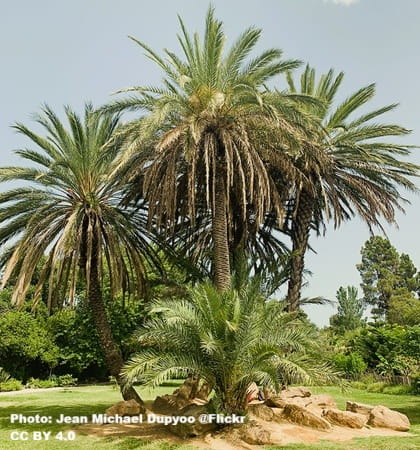 Date palms (Phoenix dactylifera) are favored for getting sap to make wine.
Date palms (Phoenix dactylifera) are favored for getting sap to make wine.Two more popular palms are tapped for sap for fermenting into a delectable wine.
- In South America the Jelly Palm (Butia capitata), from Brazil and south to Uruguay where the delicious fruit is made into jelly, but also used for palm wine.
- In parts of Asia the Sugar Palm (Arenga pinnata) is sourced for sap from the male flower stems (inflorescences).
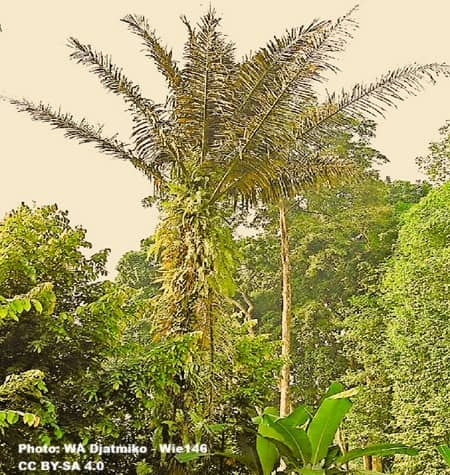 The Sugar Palm is sourced for products called toddy, tuba and saguer.
The Sugar Palm is sourced for products called toddy, tuba and saguer.Oil Palms
Two species of the oil palm are used to produce palm wine:
- Attalea speciosa (Babassu Palm). Workers drain sap from a frond stem for palm wine. Enjoyed locally in regions of northern South America east of the Andes, from Brazil through Guyana, Surinam and Bolivia.
- Elaeis guineensis (African Oil Palm) grows in west and central Africa. Flower stalks (inflorescence) are tapped to drain sap for palm wine. Its fruit is oil-rich & used for palm kernel oil production.
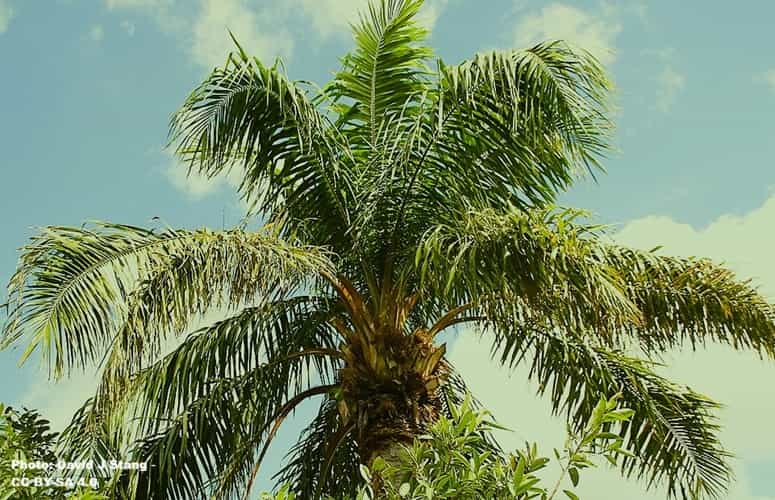 Famed for palm oil production, the African oil palm is also used for wine making.
Famed for palm oil production, the African oil palm is also used for wine making.Date Palms
Palms in the genus Phoenix are useful for wine production by using fruit or sap. People savor the mild sweetness and short fermentation timing.
- The common Date Palm (Phoenix dactylifera) makes a sweet, nutrient-rich fruity wine. It's mild alcohol level hovers around 5–11% ABV (alcohol by volume).
- Wild Date Palms (Phoenix sylvestris) are native to South Asia. Frond stems (petioles) are tapped for sap. It's then fermented to make Toddy Palm Liquor.
Raffia Palms
The main species which make palm wine are:
- Raphia hookeri (West African raffia palm). Widely growing across West and Central Africa. The prime commercial source for palm wine in that region.
- Raphia vinifera (Bamboo Palm or Wine palm). Native to tropical Africa, the name "vinifera" means "wine-bearing." It has longstanding use for palm wine production.
- Raphia farinifera is found in Madagascar and areas of East Africa. It has edible fruit, but the frond petiole is tapped for palm wine.
 Know as Madagascar raphia palm & East African wine palm.
Know as Madagascar raphia palm & East African wine palm.Where are Palm Wines Made?
Each palm wine producing region has its own names for the drink. The specific species and traditions vary significantly by local culture and available palms.
We'll help you discover the main palm species used to make wine, from African raffia sap to Asian toddy and Latin American tuba.
Africa
In Africa, oil palm and raffia palm produce popular versions of palm wine.
- Raphia species (R. hookeri, R. vinifera, R. farinifera) - primarily in West and Central Africa
- Elaeis guineensis (African oil palm) - it's widespread across tropical Africa
- Borassus aethiopum (African palmyra palm) - West and Central Africa
- Phoenix reclinata (African wild date palm) - various regions throughout the continent
Asia
Palm wine is common in India and parts of Asia. Let's see exactly where, and which species are used.
- Borassus flabellifer (Asian palmyra palm or toddy palm) - India is the primary country, but Sri Lanka and Southeast Asia are also involved.
- Nypa fruticans (nipa palm) - Mainly in Southeast Asia's Philippines, but also in Malaysia.
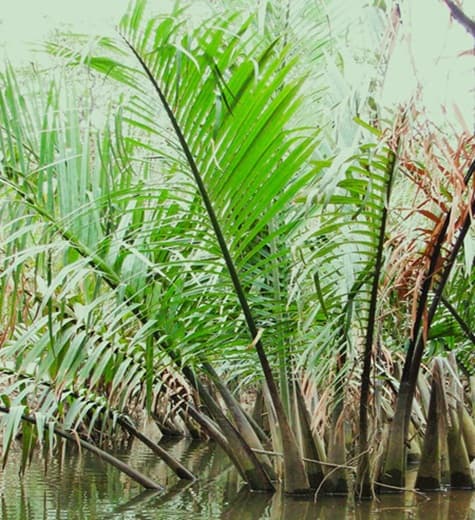 Yes, the Nypa Palm can grow in a wet swamp, as well as being a source for palm wine.
Yes, the Nypa Palm can grow in a wet swamp, as well as being a source for palm wine.- Cocos nucifera (coconut palm) - Primarily throughout Polynesia, where they use the flower stalk to make wine, distill it for arrack with increased strength. But also use the Coconut Fruit for kava-kava. Also tropical Asia produces Toddy Wine.
- Phoenix sylvestris (wild date palm or sugar date palm) - Chiefly in India, but also Pakistan.
- Caryota urens (fishtail palm) - Principally produced in India. But also in Sri Lanka, and parts of Southeast Asia
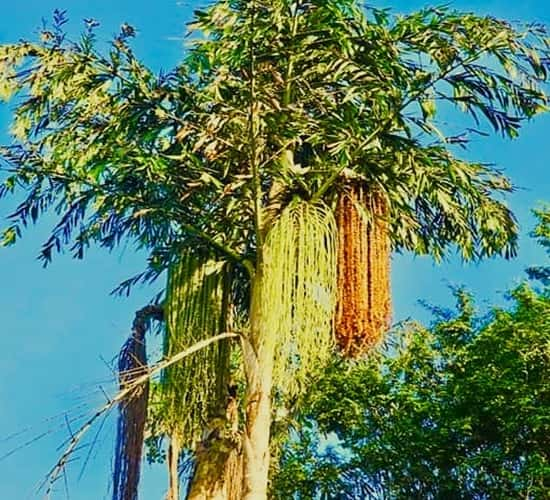 The Fishtail Palm can provide wine. It's a great shady palm, too.
The Fishtail Palm can provide wine. It's a great shady palm, too.South America
South America also has its own palm wine traditions.
- Mauritia flexuosa (moriche palm/buriti palm) - Amazon basin
- Bactris gasipaes (peach palm) - Amazon region
- Euterpe oleracea (açaí palm) - Amazon region
- Attalea species - various regions of tropical South America
 The Attalea cohune is one source for palm wine.
The Attalea cohune is one source for palm wine.In South America, the Chilean Wine Palm (Jubaea chilensis) was a prime source for sweet trunk sap.
- Formerly it was widely used to make a tasty wine. And also, a type of syrup and honey.
- But now it's protected in Chile, as almost 90% of them were cut down to make wine, honey and syrup.
- To help keep this palm around, people now cultivate it from seed.
Differences in Palm Wine Flavors & Fermentation
With all the varieties of palm wine, there are individual traditions involved in the fermentation process. Which leads to assorted flavors that are intriguing and full of character.
What is Palm Wine Flavor?
Different palm wines have slightly varied flavors. It depends on
- The palm species.
- The climate where it lives.
- What Part of The Palm is sourced for sap.
- The fermentation method.
Regional tapping methods also create differences in flavors.
Palm wine is refreshingly sweet if you drink the newly captured sap. So the taste of palm wine can range from mild and sparkling to strong and tangy.
 Once filtered & ready for imbibing, palm wine is often placed in calabasas like these.
Once filtered & ready for imbibing, palm wine is often placed in calabasas like these.How Strong is Palm Wine? Stronger Than Beer?
If you're wondering about its "kick," our research gives a clue about how much alcohol palm wine contains.
Palm wine alcohol content depends on how fast it ferments.
- Drinking it fresh from a Calabasas, when just tapped, it's mildly intoxicating. Its alcohol by volume (ABV) is then around 2%.
- After one to two days of fermentation, palm wine alcohol content increases. Then the ABV ranges from 4-6%.
Is palm wine stronger than beer? Let's look at some ABV numbers:
- Light beers range from 3.4-4.5%.
- Craft beers range from 3.8-10%.
- IPA beers (India Pale Ale) range from 5.5-20% ABF.
- But there are very strong specialty craft beers with much higher alcohol content:
- An imperial stout called Tactical Nuclear Penguin is 32% ABF
- A Scottish beer called Snake Venom has 67.5% ABF.
So, is it stronger than beer? Only for some brews, otherwise the ABF of both beer and palm wine is in the same range.
What is Palm Wine in Traditions?
Cultural Meaning, Rituals, Celebrations
Palm wine is more than a tropical drink, it’s a cultural symbol of unity, hospitality, and heritage across Africa, Asia, and the Pacific.
- It plays key roles in weddings, festivals, and rituals,
- Sharing palm wine honors ancestors, blesses unions, and strengthens community bonds.
 Sharing Palm Wine!
Sharing Palm Wine!The Cultural Role of Palm Wine
Palm wine holds deep traditional meaning in many palm-growing regions.
- In community gatherings, it’s a gesture of friendship, honor, and welcome.
- In ceremonies it links people to each other, but also to generations that came before.
- A small portion is poured out to thank the spirits, to invite good fortune before drinking begins.
From marriage blessings to ancestral offerings, it carries both sacred and social value.
What is Palm Wine used for
in Ceremonies and Celebrations?
Palm wine remains a beloved choice at weddings, naming ceremonies, harvest festivals, and cultural gatherings. It's still the choice in places where modern drinks are common.
- In many African wedding traditions, for example, the groom presents palm wine to his bride’s family, symbolizing sincerity and respect.
- Palm wine is passed around at village meetings, or raised in a toast at a festival.
 The cultural traditions involving Palm wine unites families and friends.
The cultural traditions involving Palm wine unites families and friends.What is Palm Wine for its Symbolism and Life Meaning?
Beyond ceremonies, palm wine symbolizes friendship, generosity, and belonging. Offering it to a visitor is more than friendly hospitality, it’s meant as a sign of inclusion.
We've seen how the act of sharing palm wine keeps cultural roots alive, turning an everyday drink into a living link to history and identity. Let's see if it has physical benefits beyond the cultural rituals and celebrations.
What is Palm Wine? Any Benefits? Get the Facts
Is Palm Wine Healthy?
Palm wine isn’t just refreshing and tasty, it’s rich in nutrients, probiotics, and antioxidants. Its potential health benefits have been highlighted for generations.
THE PROS:
Palm wine has come nutritional value. It contains B vitamins, amino acids, and probiotics - when it's fresh. Its natural fermentation is important, rather then using additives. Drinking it in moderation is the thing to do.
THE CONS:
The healthful benefits diminish quickly as it ferments further, with increased alcohol content. And of course, excessive drinking brings standard alcohol-related health drawbacks.
THE MYTHS:
Health claims about curing diseases have no scientific backing. While having some nutrients, it's not a health supplement or medicinal cure-all.
Palm Wine vs. Other Fermented Drinks
Curious for what is palm wine when stacked up against other traditional ferments like rice wine or cider?
Lets see the differences in taste, preparation, and cultural meaning.
- Palm wine is also called toddy (India) and tubâ (Philippines). Those are regional names for the beverage from different palm species. There are even more local names.
- Rice wine differs as it's from fermented grain rather than tree sap. Its a clearer liquid with higher alcohol content.
- While cider and rice wine fermentation is relatively slow, palm wine ferments naturally and quickly.
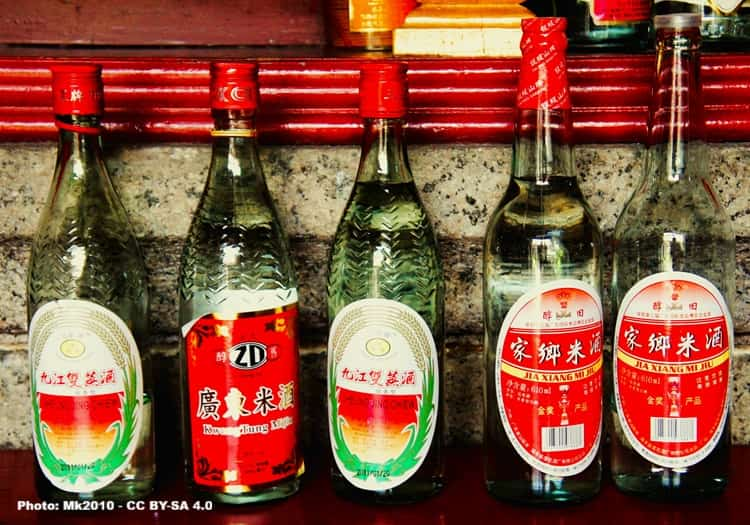 Assorted brands of rice wine.
Assorted brands of rice wine.- Cider shares palm wine's natural fermentation process but comes from fruit, not sap, with a crisper, more acidic taste.
What is palm wine? A drink that holds major cultural significance.
- Palm wine in West Africa and Southeast Asia.
- Rice wine in East Asia.
- Cider in Western traditions.
What is Palm Wine? - The FAQs
What is palm wine made from?
What is palm wine made from?
Palm wine is made from the natural sap of palm trees, such as the date palm, raffia, or coconut palm. The sap ferments quickly after tapping, creating a mildly alcoholic drink. See the Techniques for Creating Palm Wine>
Is palm wine healthy?
Is palm wine healthy?
In moderation, fresh palm wine contains vitamins, minerals, and probiotics. But excessive or uncleanly brewed versions can be unsafe. See its Benefits and Drawbacks>
How is palm wine collected?
How is palm wine collected?
See how Harvesters Tap the flower or trunk of the palm tree to collect its sweet sap in containers, usually bamboo or clay pots. The sap naturally ferments within hours.
Is palm wine alcoholic?
Is palm wine alcoholic?
Yes. Freshly tapped palm wine starts sweet and low in alcohol, but fermentation increases its alcohol content over time. Did you wonder How It Compares to Beer?
What does palm wine taste like?
What does palm wine taste like?
Fresh palm wine has a sweet, slightly tangy flavor that becomes more sour as it ferments. The taste can vary by palm species and region. So to Sample the Flavors, you may find it each is different/
Where is palm wine most popular?
Where is palm wine most popular?
Palm wine is widely enjoyed in West Africa, South and Southeast Asia, the Caribbean, and the Pacific Islands, each with distinct traditions for producing and serving it. See how those who enjoy palm wine the most compare>
Can palm wine be stored or bottled?
Can palm wine be stored or bottled?
It Can be Bottled, but this is difficult without refrigeration or pasteurization since fermentation continues rapidly, making it bitter. Some producers now make stabilized, bottled versions for wider markets.
Is palm wine the same as toddy?
Is palm wine the same as toddy?
Yes, in many regions “toddy” is another name for palm wine, especially in India, Sri Lanka, and Southeast Asia. Toddy has a Special Place in the Wine World!
Is palm wine sold in the United States?
Is palm wine sold in the United States?
It's not that easy to find palm wine in the USA. But if you live that country, you can Find Places to Make a Purchase Here>
Buy Palm Wine Online:
Authentic Brands and Where to Find Them
Looking to buy and try palm wine? Let's see if we can discover trusted brands and online stores that ship globally.
You can now buy it online from trusted sources. Popular brands like Nkulenu’s (Ghana) and Tua Sabu (Indonesia) offer authentic, bottled palm wine with rich cultural roots.
For safe purchases, stick to reputable marketplaces like Amazon or Makola Stores. You may find curated selections through wine blogs or specialty African food sites.
Mission: Palm Trees is made possible by readers like you! If you purchase via a link/ ad here, we may earn a small commission. At no added cost to you. Thanks for your support! Learn more>
Always check reviews and shipping details to ensure freshness and authenticity.
REFERENCES:
ARK Behavior Health (2021, Sept 2). Beer Alcohol Content | How Much Alcohol Is In Beer? Retrieved from arkbh.com/alcohol/types/beer/alcohol-content/
SNBC (2024, Aug 30). What is the difference between pale ale and IPA? Retrieved from sierranevada.com/blog/our-beer/pale-ale-vs-ipa3
Dogfish Head Ale House (nd). 120 Minute IPA. Retrieved from dogfishalehouse.com/beers/ 120-minute-ipa/
Jones, D.L. (1995) Palms throughout the world. Smithsonian Institution Press.
Oluwole,O., Kosoko,S., Familola,O., Ibironke,O., Cheikhyoussef,A., Raheem,D., Saraiva,A. & Raposo,A. (2023, Oct. 21) Fermented traditional wine from palm trees: Microbial, nutritional attributes and health impacts. Frontiers in Food Science and Technology. Vol.3. doi.org/ 10.3389/frfst.2023.1225762
Hai,A., Rambabu,K., Al Dhaheri,A.S., Kurup,S.S., Banat,F. (2024, Aug 2). Tapping into palm sap: Insights into extraction practices, quality profiles, fermentation chemistry, and preservation techniques. Heliyon;10(15):e35611. doi: 10.1016/j.heliyon.2024.e35611. PMID: 39170275; PMCID: PMC11336882.
Djeni,T.N., Kouame,K.H., Ake,F.D.M., Amoikon,L.S.T., Dje,M.K., Jeyaram,K. (2020, Feb 3). Microbial diversity and metabolite profiles of palm wine produced from three different palm tree species in Côte d’Ivoire. Scientific Reports; 10,1. doi.org/10.1038/s41598-020-58587
Olaigbe,O. (2023, May 8). In Nigeria, palm wine celebrates the human experience. wineenthusiast.com/culture/spirits/nigeria-palm-wine-culture-history/
Carucci, L.M. (1987, Dec). Jekero: Symbolizing the transition to manhood in the Marshall Islands. Vol.20, Micronesia. Bozeman MT, Department of Sociology, Montana State University. Retrieved from micronesica.org/sites/default/files/jekero_symbolizing_caruccio.pdf
National Mission on Culture (n.d.) Ghana’s palm extracts: A legacy of heritage and culture. GhanaCulture.gov, retrieved from ghanaculture.gov.gh/ghanas-palm-extracts-a-legacy-of-heritage-and-culture/
Nzam, S.T. (2024, Aug 13). Palm wine benefits economy in the Central African Republic. Central African Republic, Africa News. Retrieved from africanews.com/2021/12/17/palm-wine-benefits-economy-in-the-central-african-republic/
Ogunnaike, A. (2019). The Tree That Centers The World: The Palm Tree as Yoruba Axis Mundi. Africana Studies Review. Retrieved from academia.edu/40208012/The_Tree_That_Centers_The_World_The_Palm_Tree_as_Yoruba_Axis_Mundi
Salvador, G. (2025, Oct 21) Palm wine, the African champagne: Symbolic, cultural, ritual and social roles of Africa’s native drink. Oriire, retrieved from oriire.com/article/palm-wine-the-african-champagne-symbolic-cultural-ritual-and-social-roles-of-africa-s-native-drink
Slow Food (n.d.) Palm Wine. Ark of Taste, Slow Food Foundation for Biodiversity. Retrieved from fondazioneslowfood.com/en/ark-of-taste-slow-food/palm-wine-2/
Onyeodili,A.O., Okafor,G.I., Okoyeuzu,C.F., Nduka,O.C., Okechukwu,Q.N., Hassani,M.I., et al. (2025) Sustainable alternative of palm wine analogue from different tiger nut milk-sugar syrup blends for local production. Explor Foods Foodomics. 3:101069. doi.org/10.37349/ eff.2025.101069
Bisola (2025). Igbo wedding traditions: The timeless tradition of the Palm Wine Ceremony. eventdesignbybe.com/igbo-wedding-traditions-the-timeless-tradition-of-the-palm-wine-ceremony/
Ephanov,N. (2024, July 10). What Is palm wine and why is it so popular in India? Tasting Table: tastingtable.com/1614106/what-is-palm-wine-india/
Mireva,K. (n.d.) Types of palm wine: A deep dive into different palm wines. binwise blog, home.binwise.com/blog/types-of-palm-wine
Dalibard,C. (1999) Overall view on the tradition of tapping palm trees and prospects for animal production. Livestock Research for Rural Development. Volume 11, Article #5. lrrd.org/lrrd11/1/dali111.htm
Shetty,P. et al. (2017) Int. J. Appl. Sci. Biotechnol. Vol 5(3): 375-381. DOI: dx.doi.org/ 10.3126/ijasbt.v5i3.18297
What is Palm Wine? The Takeaways
Palm wine comes from numerous tropical countries.
Creating wine from palms takes several varied methods. Its alcohol content is similar to many beer products. You might want to try it, but keep in mind authentically shopping for it.

